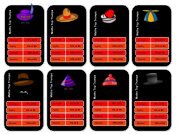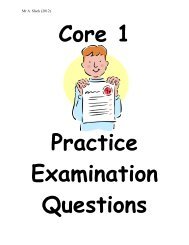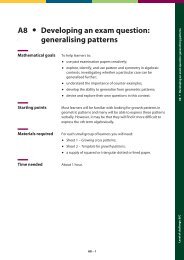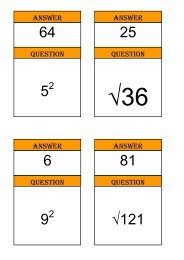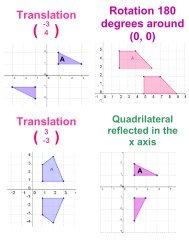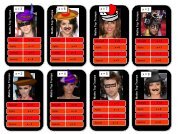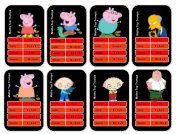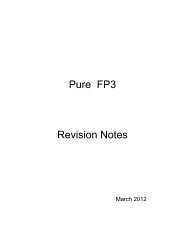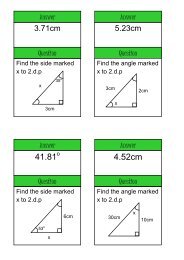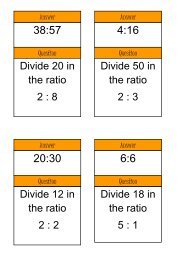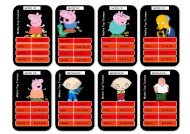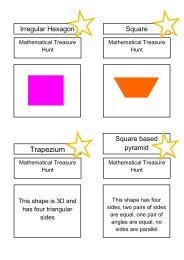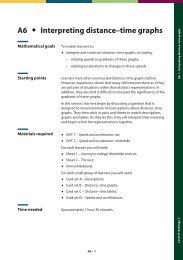S2 Evaluating probability statements - Great Maths Teaching Ideas
S2 Evaluating probability statements - Great Maths Teaching Ideas
S2 Evaluating probability statements - Great Maths Teaching Ideas
Create successful ePaper yourself
Turn your PDF publications into a flip-book with our unique Google optimized e-Paper software.
Level <strong>S2</strong> of challenge: B/C<strong>S2</strong>Mathematical goalsStarting pointsMaterials requiredTime needed<strong>Evaluating</strong> <strong>probability</strong> <strong>statements</strong>To help learners to: discuss and clarify some common misconceptions about<strong>probability</strong>.This involves discussing the concepts of: equally likely events; randomness; sample sizes.Learners also learn to reason and explain.This session assumes that learners have encountered <strong>probability</strong>before. It aims to draw on their prior knowledge and develop itthrough discussion. It does not assume that they are alreadycompetent.For each learner you will need: mini-whiteboard.For each small group of learners you will need: Card set A – True, false or unsure?Between 30 minutes and 1 hour. The issues raised will not all beresolved in this time and will therefore need to be followed up inlater sessions.Level of challenge: B/C <strong>S2</strong> <strong>Evaluating</strong> <strong>probability</strong> <strong>statements</strong><strong>S2</strong>–1
Finally, as a whole group, tackle the <strong>statements</strong> that learners are notso sure about.Try to draw out the following points, preferably after learners havehad the opportunity to do this in their own words.Statements B and H are true. For B it is enough to noticethat there are two ways of obtaining a total of 3 (1,2 and2,1), whereas there is only one way of obtaining a score of2. For H, it is enough to notice that there are more learnersthan days of the week.The remaining <strong>statements</strong> offer examples of commonmisconceptions.‘Special’ events are less likely than ‘more representative’events.Statements A and C are indicative of this misconception. In bothcases the outcomes are equally likely. Some learners remembertrying to begin a game by rolling a six and it appeared to take along time. The special status of the six has thus becomeassociated with it being ‘hard to get’. Others may think that theyincrease their chances in a lottery or raffle by spreading out theirchoices rather than by clustering them together. In fact thismakes no difference.All outcomes are assumed to be equally likely.Statements D and E are typical examples. The different outcomesare simply counted without considering that some are muchmore likely than others. For D, there are in fact four equally likelyoutcomes: HH, HT, TH, TT. Clearly, the probabilities for E willchange whether the opposing team is Arsenal or Notts County.Later random events ‘compensate’ for earlier ones.This is also known as the gambler’s fallacy. Statements G and Iare indicative of this. Statement G, for example, implies that thecoin has some sort of ‘memory’ and later tosses will compensatefor earlier ones. People often use the phrase ‘the law of averages’in this way. Sample size is irrelevant.Statement J provides an example of this subtle misconception.The argument typically runs that, if the <strong>probability</strong> of one headin two coin tosses is 1 , then the <strong>probability</strong> of n heads in 2n coin2tosses is also 1 . In fact the <strong>probability</strong> of three out of six coin2Level of challenge: B/C <strong>S2</strong> <strong>Evaluating</strong> <strong>probability</strong> <strong>statements</strong><strong>S2</strong>–3
<strong>S2</strong> Card set A – True, false or unsure?AWhen you roll a fair six-sided die, itis harder to roll asix than a four.CBScoring a total of three with twodice is twice aslikely as scoringa total of two.D<strong>S2</strong> <strong>Evaluating</strong> <strong>probability</strong> <strong>statements</strong>In a lottery, the six numbers3, 12, 26, 37, 44, 45are more likely to come up thanthe six numbers 1, 2, 3, 4, 5, 6.EThere are three outcomes in afootball match: win, lose or draw.The <strong>probability</strong> ofwinning istherefore 1 3 .When two coins are tossed thereare three possible outcomes:two heads, one head or no heads.The <strong>probability</strong> of two heads istherefore 1 3 .FIn a ‘true or false?’ quiz with tenquestions, you arecertain to get five rightif you just guess.GIf you toss a fair coin five times andget five heads in a row, the nexttime you toss the coin it is morelikely to show a tail than a head.HIn a group of ten learners, the<strong>probability</strong> of twolearners being bornon the same dayof the week is 1.IIf a family has already got fourboys, then the nextbaby is more likelyto be a girlthan a boy.JThe <strong>probability</strong> of getting exactlythree heads in six coin tosses is 1 2 .<strong>S2</strong>–5



